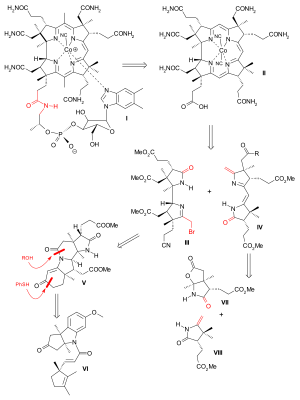Total synthesis
In medicinal chemistry, natural product synthesis is essential for creating bioactive compounds, driving progress in drug discovery and therapeutic development.
[9][10] The field of natural product synthesis has progressed remarkably since the early 19th century, with improvements in synthetic techniques, analytical methods, and an evolving understanding of chemical reactivity.
Key components of natural product synthesis include retrosynthetic analysis, which involves planning synthetic routes by working backward from the target molecule to design the most effective construction pathway.
Although untrue from an historical perspective (see the history of the steroid, cortisone), total synthesis in the modern age has largely been an academic endeavor (in terms of manpower applied to problems).
The Phil S. Baran group at Scripps, a notable pioneer of practical synthesis have endeavored to create scalable and high efficiency syntheses that would have more immediate uses outside of academia.
[2] Wöhler obtained urea by treating silver cyanate with ammonium chloride, a simple, one-step synthesis: Camphor was a scarce and expensive natural product with a worldwide demand.[when?]
The American chemist Robert Burns Woodward was a pre-eminent figure in developing total syntheses of complex organic molecules, some of his targets being cholesterol, cortisone, strychnine, lysergic acid, reserpine, chlorophyll, colchicine, vitamin B12, and prostaglandin F-2a.
"[27] Another gifted chemist is Elias James Corey, who won the Nobel Prize in Chemistry in 1990 for lifetime achievement in total synthesis and for the development of retrosynthetic analysis.
